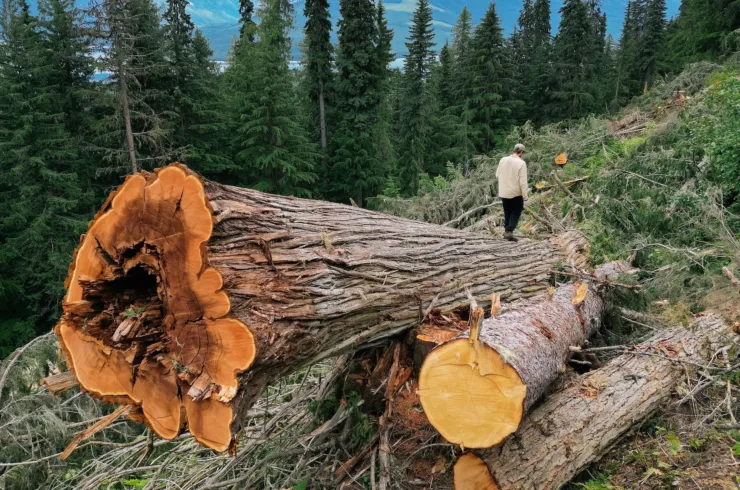Quiet footfalls pass through the deep mossy undergrowth, the air wet and windy. Under the shelter of towering old-growth cedar trees, the worst of the weather is blocked as the small group carefully hunts the ground for unusual prey: mushrooms.
This is BC’s Inland Temperate Rainforest (ITR), one of the last left on Earth, a vast ecosystem that once covered 40 million acres stretching from northern B.C. to central Idaho. In this corner of the ITR, along the Downie Arm near Revelstoke, B.C., you’ll find cool, wet forests of ancient cedars and hemlocks, and a remarkable diversity of life — from deep-snow caribou and old-growth dependent birds, to rare plants, lichens and fungi.
This October, five keen Wildsight volunteers ventured into these forests as part of a continent-wide MycoBlitz (a hunt for mushrooms). Their goal: to put Revelstoke’s ITR on the North American mycological map.

The Continental Mycoblitz is an annual event that helps paint a picture of mushroom diversity across North America and track distribution patterns.
The team spent about four hours in the forest, finding more than 50 different mushroom species up high and down low in the dense undergrowth. Each one was not only unique-looking but had varied scents too, from sweet to savoury!
For a mushroom enthusiast, finding fungi is a joyful hunt. Each mushroom feels a little like stepping through the looking glass. With a camera lens pointed close, the world shifts; thumb-sized mushrooms tower overhead, their gills drawing straight lines on the underside of the mushroom’s cap. All shades of moss and lichen paint the forest in hues of green, where curiouser and curiouser mushrooms are found. Droopy-capped mushrooms and tiny earthworm-like clusters reach skyward; gilled caps like miniature parasols and wide-brimmed caps shade reed-thin stems. Others rise out of the forest floor like ocean coral, fairy hats or tiny ghosts strung on a line.
Volunteers spotted a Fragrant Funnel: a name that feels pleasing on the tongue, if not on the tastebud (while it smells sweet, this species is considered toxic). Nearby, they find a frothy porecrust, looking like a tactile delight with deep lines down its circular shape blotting the bark of a decaying hemlock.
The diversity of mushrooms indicates a strong, healthy ecosystem here in this pocket of the ITR, says Reanne Harvey, Wildsight North Columbia Conservation Coordinator and Revelstoke Branch Manager, who led this MycoBlitz. She says it was remarkable to see the sheer number of mushroom species found in one location.
“There was just so much to see — so many mushrooms — in quite a small area,” shares Reanne. “It was impressive!”
The ITR excursion was part of the North America-wide MycoBlitz, an annual event that helps paint a continent-wide picture of mushroom diversity. As they wandered through old growth, the team took photos of each mushroom they found, later uploading the georeferenced images to iNaturalist, a citizen-science platform.
The Revelstoke MycoBlitz findings adds to the growing database of knowledge about the ITR.
“I knew it was a diverse ecosystem, but seeing it this way was really eye-opening. I hope it helps put the ITR on the map as an important ecosystem for fungi,” says Reanne.
An intact ecosystem
The team also brought along a measuring tape so they could get a good look at some of the Downie Arm’s oldest inhabitants. While hunting for the mushrooms, the volunteers measured about half a dozen cedar trees that measured more than 2 metres in diameter. The largest was 2.8m! These inland giants are estimated to be more than 1,000-years old, and provide critical structure to the old growth ecosystem.
The Downie Arm is in an old growth deferral area, meaning the provincial government has put a pause on logging in this particular area. Finding such a diversity of life in a small area shows that this area is better left intact, and highlights the importance of logging deferrals. Protecting the old growth here protects the entire ecosystem held within its forest canopy.
Revelstoke’s MycoBlitz was inspired by similar events in Golden led by biologist Rachel Darvill. She urged Wildsight to conduct a similar mycoblitz in the ITR to help ensure this area is represented on the North American mycological map.

Future plans
This past fall’s ITR MycoBlitz was deliberately small, focused on gathering high-quality observations with participants who have a background in foraging. But Reanne anticipates more public events in the
ITR’s fungi-filled forest next year. Keep an eye on Wildsight’s event listings for future ITR events.










